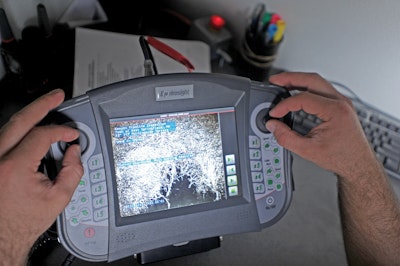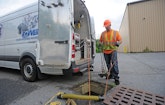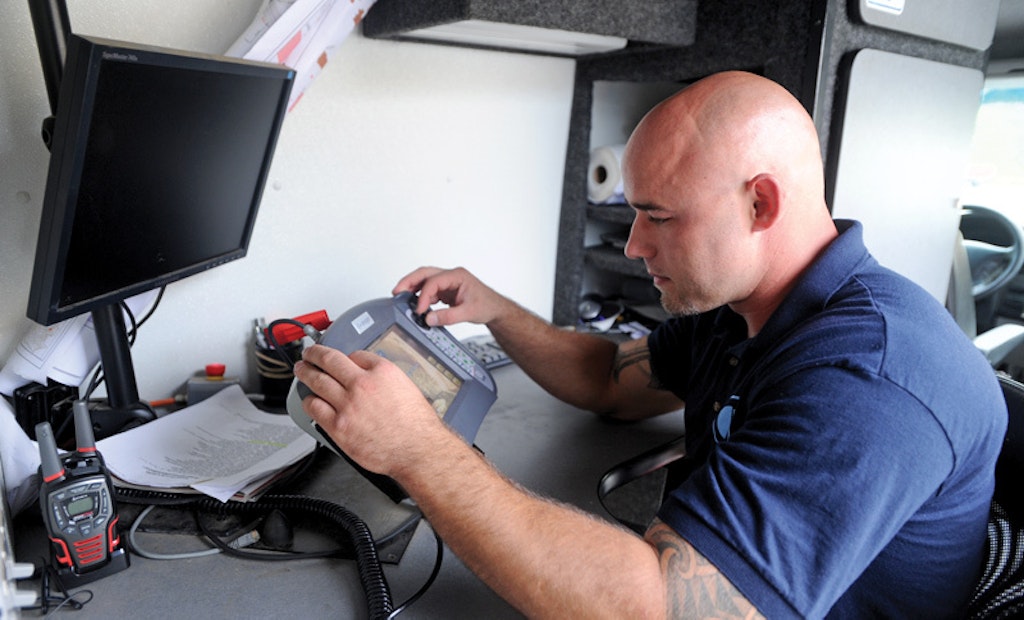Interested in Inspection?
Get Inspection articles, news and videos right in your inbox! Sign up now.
Inspection + Get AlertsWhen brothers Jake and Josh Kenyon were unexpectedly downsized from their jobs at a contracting company in upstate New York in August 2011, it would’ve been easy to get discouraged.
But instead of wringing their hands, Jake, 34, and Josh, 33, sat down over coffee the same day and discussed their options. Both men had always wanted to own their own company, and their abrupt dismissal only bolstered the desire to control their own destiny. So they decided to strike out on their own.
Two years later, the brothers are doing well with Kenyon Pipeline Inspection (KPI), which provides sewer cleaning and pipeline inspection services in New York and the New England area. They own two vacuum trucks and two pipeline inspection systems, and recently added a second work crew, bringing the company’s total employment to six. Through the first half of this year, KPI had earned more revenue than it did in all of 2012, the company’s first full year in business.
Fast start
Several factors helped fuel their professional rebound: a willingness to embrace and invest in new technologies, such as pipe relining and inspection cameras; an equipment dealership, Joe Johnson Equipment Inc., in Albany, which worked out a rent-to-own deal on the first vacuum truck and inspection camera/camera truck; a zeal for providing top-notch customer service; and the ability to develop and nurture business relationships.
The brothers have built up an impressive fleet of equipment in just two years, worth about $1 million. KPI owns a 2001 Vac-Con V312LHA vacuum truck, built on a Sterling truck chassis and featuring a 12-cubic-yard debris tank, a 1,500-gallon water tank, a blower that generates vacuum power of 3,425 cfm at 14 1/2 inches of mercury and a pump manufactured by FMC Technologies Inc. (80 gpm at 2,000 psi). They also have a Vactor 2100 vacuum truck, built on a 2009 Mack truck chassis and featuring a 12-cubic-yard debris tank, a 1,500-gallon water tank and a Vactor blower (8,000 cfm at 16 inches of mercury) and pump (80 gpm at 2,000 psi).
In addition, the company owns a 2007 Sprinter van that carries a Rovver X inspection-camera system made by Envirosight; a 2003 Freightliner FL70 15-foot box truck that carries another Rovver X camera, as well as a lateral-reinstatement cutter made by Schwalm Robotic GmbH; a 2003 Isuzu 15-foot box truck; a late 1990s Ford box truck; a VeriSight push camera, made by Envirosight, used for inspecting residential sewer laterals; and a pipe relining system from Perma-Liner Industries LLC.
The company’s customer base is about 90 percent municipal agencies and 10 percent commercial/industrial customers. Inspecting and cleaning sanitary and storm sewers accounts for about 70 percent of the company’s revenue; pipe relining generates about 30 percent, Jake Kenyon estimates.
After developing a business plan, talks with various banks about funding a business startup went nowhere fast. So the rent-to-own arrangement with Joe Johnson Equipment was critical, Kenyon says.
“We gave them a down payment and that’s how we got started,” he says. “We couldn’t have gotten started without that. There was no standardized funding out there for startup companies. We really lucked out that they had faith in my brother and me.”
Steve Webster, director of New York operations for Joe Johnson Equipment, says it was a no-brainer because they had contacts and were already lining up work. “All they needed was the equipment to get them up and running,” he says. “Not only did they stick their necks out and go for it, but they’ve been very successful in a short period of time.”
The brothers’ startup aspirations were aided by relationships with municipalities, developed over the 15 or so years they’d already spent working in the industry. The duo started to reach out to those potential customers, explaining the services they could provide and the equipment they’d purchased. Kenyon said the latter was critical to obtaining business.
“I’ve learned that you have to spend money to make money,” he explains. “When we bought our first [pipeline] camera, we bought what we could afford. It wasn’t the newest technology, but it was better than what many competitors owned.
“But within the first four months, we were doing well enough that we could upgrade to the Rovver X, which offers better video quality and improves productivity,” he continues. “We let people know that we were reinvesting in the company to provide customers with the best video quality available. The better data and quality of services you offer, the more people want to use you.
“I think the new camera helped reassure people that we weren’t just a seat-of-the-pants company,” he adds. “It cost around $100,000 with all the accessories, so from the customers’ perspective, it looked like we were planning on being around for the long haul.”
Treating people right
Providing reliable customer service has also been key to the company’s growth. Kenyon says that every customer they’ve worked for has provided at least one qualified word-of-mouth referral. As a result, KPI was able to hire another crew to man its second vacuum and camera trucks in May.
“It was pretty nerve-racking – just as bad as starting out fresh,” Kenyon says about adding the new employees. “Now we rely more than ever on our employees, rather than just ourselves, which means giving up some control over things. That’s hard to do.
“But we take a lot of pride in everything we do,” he adds. “It’s our name on the trucks. We always go above and beyond, no matter what project we’re on. A lot of companies don’t like to let their employees solve problems … or when they run into a situation they’ve never dealt with before, they tell their customers there’s nothing they can do.
“But we take time to analyze situations and suggest solutions. Maybe we’ll come back to a job at non-peak-flow hours and see what’s going on, for instance. We try to think outside the box and provide solutions to problems.”
For example, last February, KPI got an emergency call at 10 p.m. on a Saturday night from a municipal customer with a blocked easement sewer. There was more than a foot of snow on the ground and temperatures had dipped below zero. Nonetheless, a KPI crew headed out.
The line contained so much grease that inspecting it by camera was impossible. Moreover, the sewer line was fully surcharged, which blocked access to the two nearest upstream and downstream manholes. So the KPI crew attacked the blockage with various nozzles. They finally broke through the clog with a front-spray, chisel-point nozzle.
“It was like working while blind,” Kenyon notes. “We finally finished up at 2:30 or 3 a.m. Later we went back and televised the line, which revealed that a pipe had shorn off, allowing sand to enter the pipe, which congealed with the grease. They ended up excavating and putting in a new pipe.”
Developing new business
Kenyon says he and his brother strive for regular contact with local municipal engineers to see what kind of infrastructure rehab projects are in the works. “A lot of it requires just talking with past and potential clients,” he points out. “They’re always looking for ideas … if they’re asking questions about different ways to stop water [inflow and infiltration], then chances are they may be starting an I&I study. It’s important to stay in contact and try to anticipate their needs.”
Developing a website also has helped the company grow. Kenyon says he had low expectations about the value of an Internet presence, but that it’s generated more job leads than he anticipated. Initially, he says he and his brother just wanted an Internet presence so people could easily find basic information about the company and its services if they didn’t want to take the time to call.
“People are very tech savvy now,” he says. “There are a lot of newly hired engineers [at municipal agencies] who are just out of college and are used to going to the Web for everything. Speaking for myself, I find that if I can’t find a company on the Web, I’m a little leery myself. People just expect it. Overall, I’d say we’ve obtained six jobs off the website from customers who we’ve never worked for before, so it was well worth doing.”
Ready for the future
Looking ahead, Kenyon says one of the company’s biggest challenges is growing at a manageable pace. He believes that when companies grow too fast, core values – like providing the best service possible to clients in timely, efficient fashion and finishing projects on time and on budget – tend to slip.
“We’re constantly monitoring things so that we don’t take on more than we can chew,” he explains. “On the other hand, in order to grow, we need to take on bigger projects. And to do that, bonding becomes an issue, and so does the cost of insurance. Plus you need more equipment and employees, too. You almost have to make sure you have way too much work for your current crews to do before you consider adding another crew.
“We felt comfortable making the first jump [adding a second crew] because we were getting to the point where we were thinking about turning work away,” he continues. “You can’t do that. If you turn away customers, they won’t necessarily call back tomorrow.”










